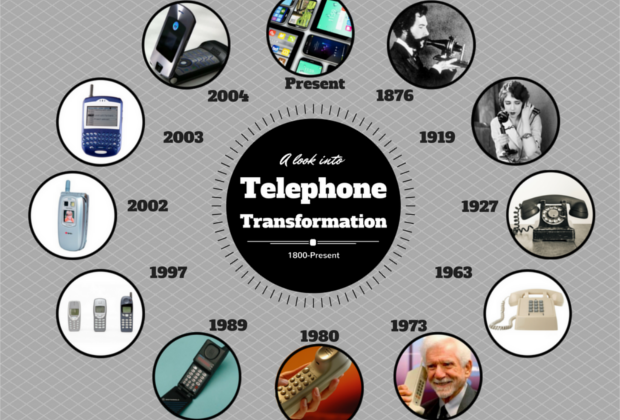
The smartphones we possess today have come a long way from the first rendition of the telephone back in 1876 when Alexander Graham Bell invented and patented the first short-range phone. But like people, phones have evolved throughout history to cater to our lifestyles and needs.
Here’s a look at how telephones have transformed over the years…
Short-Range Phone: Despite a number of individuals from around the world who’ve contributed to the invention of the telephone, Alexander Graham Bell was the first to receive a patent for his short-range phone in 1876. Testing out the phone in his Boston laboratory, he rang his assistant Thomas Watson, and become well known-for saying, “Mr. Watson, come here – I want to see you.”
Candlestick Phone: The candlestick phone became popular in the 1890s through the 1930s. Separated by two pieces, it featured a mouth piece (transmitter) mounted at the top of the stand, and a receiver (ear phone) that the user would hold to their ear during a call.
Rotary Phone: Pushing out the candlestick phone, the rotary phone came about in the 1930s when manufacturers began to combine the mouth piece and receiver of the candlestick phones into a single unit. When dialing a rotary phone, what originally started as lugs, but evolved into holes, one would then rotate the dial to the number that they wanted and then would release the dial.
Touch-Dial Phone: On November 18, 1963, the Bell System unveiled the first electronic touch-dial phone system with touch-tone dialing. It would become the worldwide standard for telecommunication signaling. Using audible tones for each of the digits on the push-button keypad, specific frequencies were designated to each row and column. The tones helped the switching center determine which key was pressed.
First Mobile Phone: On April 3, 1973, Motorola researcher and executive, Martin Cooper, made the first mobile telephone from handheld subscriber equipment. Weighing in at 2.4 lbs and measuring at 228.6 x 127 x 44.4mm, Cooper was said to have called a rival telecommunications company and let them know he was talking to them on a mobile phone. The prototype was able to give a caller 30 minutes of talk-time and took about 10 hours to charge.
Cordless Phone: Cordless phones became a hot commodity in the 1980s but was originally invented by a female Jazz musician named Teri Pall in 1965. The handset cord of the telephone was replaced with a radio link. However, Teri’s invention would not hit the consumer market until a decade and a half later.
First Portable Phone: Even though Martin Cooper invented the first mobile phone, the first portable mobile phone was the MicroTAC which was introduced in 1989 as “an innovative new “flip” design”, where the “mouthpiece” folded over the keypad, although the “mouthpiece” was actually located in the base of the phone, along with the ringer. Up until its release, most cellular phones were installed as car phones due to the inability to fit them into a jacket pocket.
Nokia: Through the mid-90s and into the early 2000s, Nokia mobile phones catered to consumers, with interchangeable faceplates, customizable designs, the first WAP browser, internal antenna, T9 Text messaging, and eventually an LCD screen and internet connectivity.
First Camera Phone (Sanyo SCP-5300): Possessing the first camera phone, the U.S. finally adopted the Japanese trend in November 2002. The clunky clamshell design could capture photos at 640×480 pixels and had a basic flash, white balance control, self-timer, digital zoom, and various filters (sepia, black and white, and negative colors.)
Crack-Berry (BlackBerry): Blackberry made waves with their popular RIM communication device in 2003 which possessed a phone, PDA, and e-mail system all in one hand-held phone. The term crack-berry came about when users constantly checked their e-mail and sent short messages through their device.
Sleek Mobile Design (Motorola Razr): First developed in 2003, the Motorola Razr hit it big when it was marketed as a fashion phone due to its sleek and thin profile. Over its four-year run, they sold over a 130 million phones and were named the best-selling clamshell phone in history.
Smartphones: Dating back as far as 1997, it wasn’t until Japan became the first mobile market to popularize the smartphone in 1999. As BlackBerry, Palm, HTC, Windows Mobile, Samsung, Nokia, and Motorola made a name for themselves in the early 2000s, their smartphones had the capability to email, fax, and search the internet. As the smartphone craze escalated, cell phone manufacturers tested a number of functionalities that would help them capitalize on the new trend. From sliding, flipping, rotating, vertical, and even multiple keyboards, touchscreen smartphones made their way into the market which also introduce the stylus. However, the functionality these phones offered were still targeting more business users versus consumers.
Cue in iPhone 3G. The first of its kind, the original iPhone was the first touch-screen smartphone that was unveiled in June 2007. Apple’s take on the smartphone combines “multimedia functions with the same email and Web browsing features as all other smartphones previously had. It had a large color display with a capacitive digitizer, and its user interface was finally finger-friendly. And unlike phones before it, the iPhone had only one button on its face – the Home button – and three around its edges, two for volume up/down and one for power/standby.” reports the “The Evolution of the Smartphone” from PocketNow.
Today, iPhone has paved the way for a number of other cell phone manufacturers to create their own version of the smartphones we love today. However, this is only the tip of the iceberg on how phones have evolved over history, but it’s apparent that as phones change, engineers will cater to the needs of consumers. What do you think the evolution of phones will come up with next?
Keep on top of all the trends in Voice with Hiya's State of the Call report below.




